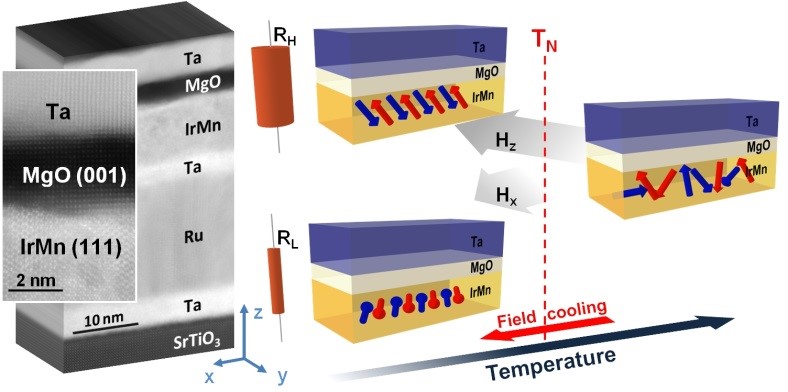Spintronics is an important area of modern condensed matter physics which has led to new means for reading, writing and storing information. Magnetic tunnel junctions (MTJs) used in modern hard-drive read heads and magnetic random access memories comprise two ferromagnetic electrodes whose relative magnetization orientations can be switched between parallel and antiparallel configurations, yielding to two different memory states via the magnetoresistance effect. In spintronics, ferromagnets play, at the moment, an undismissable role, but from the applications perspective, it is particularly appealing the introduction of antiferromagnetic memory elements insensitive to external magnetic fields .
Our research is devoted to the fabrication of antiferromagnetic tunnel junctions (ATJs) and devices based on the anisotropic magneto-resistance (AMR) effect, acting as electrically readable memories where the information is stored in antiferromagnetic materials (AFM). In comparison with ferromagnets, antiferromagnetically ordered components produce zero stray field and are more robust against magnetic field perturbations, thus allowing for larger packing density ad higher reliability and durability. Indeed in ATJs metastable states corresponding to different spin configurations of the AFM can be set by cooling the sample and crossing the Néel temperature in external magnetic fields of different orientations. These metastable states can be detected electrically due to the AFM tunneling anisotropic magnetoresistance (TAMR).
Research activity is devoted to
- realizing IrMn-based ATJs on Silicon platforms, looking for CMOS compatibility, with operation temperature larger or equal than room temperature [1-3]
- exploring the AFM properties of Chromium and Chromium oxide thin films, looking for the possibility of a magneto-electric control via proximity with a ferroelectric material (e.g. BaTiO3) [4-8]
- characterizing the electronic properties of unconventional antiferromagnets (CuMnAs) [9]
In parallel, ab-initio calculations in collaboration with the SPIN-CNR unit of L’Aquila (S. Picozzi) will address alternative ways of information writing (magnetoelectric coupling), as well as novel materials (Mn2Au), in order to propose new pathways to be followed and experimentally investigated [10].

Prototypical AFM-based memory device: (a) heterostructure stack; (b) working principle. The device is heated above its Néel temperature (TN) and then cooled down with applied magnetic field, either in the out-of-plane (HZ) or in-plane (HX) direction. The resulting TAMR (Tunneling Anisotropic Magneto-Resistance, defined as the percentage variation of the resistance after field cooling with HZ or HX) is 8% at 25 K.
For more information see the web page of project MAGISTER (Magnetic Information Storage in Antiferromagnetic Spintronics Devices)
References
- C. Rinaldi, L. Baldrati, M. Di Loreto, M. Asa, R. Bertacco, and M. Cantoni, “Blocking Temperature Engineering in Exchange-Biased CoFeB/IrMn Bilayer”, IEEE Transactions On Magnetics 54, 1 (2018), doi: 10.1109/TMAG.2017.2787623
- M. Asa, C. Rinaldi, R. Pazzocco, D. Petti, E. Albisetti, R. Bertacco, and M. Cantoni, “Electrical readout of the antiferromagnetic state of IrMn through anomalous Hall effect”, J. Appl. Phys. 128(5), 053904 (2020)
- M. Asa, G. Vinai, J. L. Hart, C. Autieri, C. Rinaldi, P. Torelli, G. Panaccione, M. L. Taheri, S. Picozzi, and M. Cantoni, “Interdiffusion-driven synthesis of tetragonal Chromium (III) oxide on BaTiO3”, Phys. Rev. Materials 2, 033401 (2018)
- M. Asa, C. Autieri, C. Barone, C. Mauro, S. Picozzi, S. Pagano, and M. Cantoni, “Detecting antiferromagnetism in tetragonal Cr2O3 by electrical measurements”, Phys. Rev. B 100, 174423 (2019), doi: 10.1103/PhysRevB.100.174423
- C. Rinaldi, M. Asa, D. Chrastina, J. L. Hart, M. L. Taheri, I. Pallecchi, D. Marré, and M. Cantoni, “Study and optimization of epitaxial films of Cr and Pt/Cr bilayers on MgO”, Journal of Physics D: Applied Physics 53, 105303 (2019), doi: 10.1088/1361-6463/ab6148
- M. Asa, C. Autieri, R. Pazzocco, C. Rinaldi, W. Brzezicki, A. Stroppa, M. Cuoco, G. Varvaro, S. Picozzi, and M. Cantoni, “Anomalous Hall effect in antiferromagnetic/nonmagnetic interfaces”, Phys. Rev. Research 2, 043394 (2020), DOI: 10.1103/PhysRevResearch.2.043394
- M. Asa, C. Rinaldi, l. Nessi, D. Chrastina, D. Petti, E. Albisetti, R. Bertacco, and M. Cantoni, “Epitaxy and controlled oxidation of Chromium ultrathin films on ferroelectric BaTiO3 templates”, J. Cryst. Growth 558, 126012 (2021)
- M. Veis, J. Minár, G. Steciuk, L. Palatinus, C. Rinaldi, M. Cantoni, D. Kriegner, K. K. Tikuišis, J. Hamrle, M. Zahradník, R. Antoš, J. Železný, L. Šmejkal, X. Marti, P. Wadley, R. P. Campion, C. Frontera, K. Uhlířová, T. Duchoň, P. Kužel, V. Novák, T. Jungwirth, and K. Výborný, “Band structure of CuMnAs probed by optical and photoemission spectroscopy”, Phys. Rev. B 97, 125109 (2018)
- E. Plekhanov, A. Stroppa, and S. Picozzi, “Magneto-electric coupling in antiferromagnet/ferroelectric Mn2Au/BaTiO3 interface”, Journal of Applied Physics 120, 074104 (2016)
Involved People
Former members
- Lorenzo Baldrati
- Matteo di Loreto
- Riccardo Pazzocco